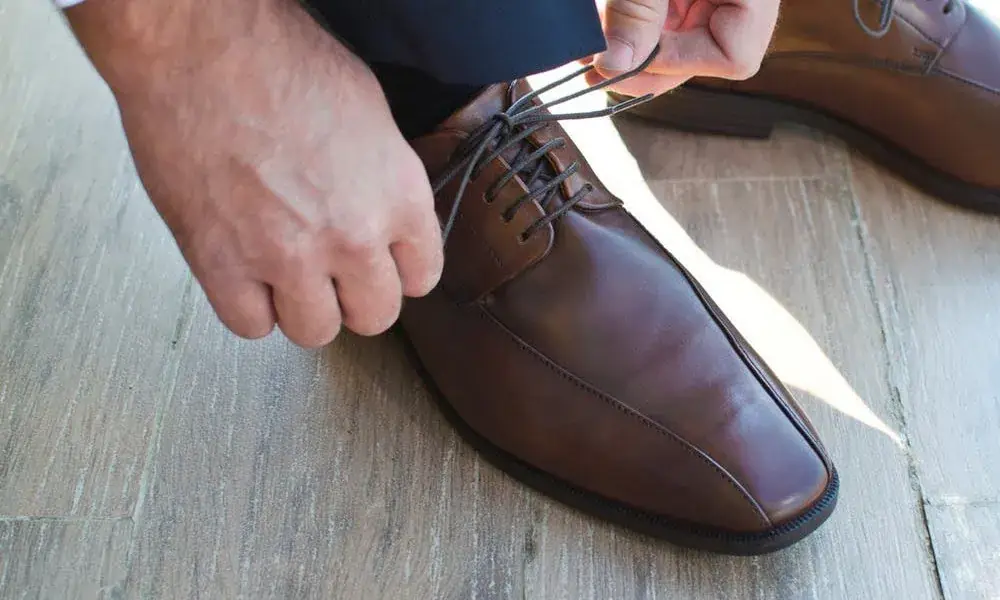Have you ever slipped on a pair of shoes you haven’t worn in a while, only to find they feel tighter or looser than you remember? It’s not just your imagination—your feet can actually change size over time. As a podiatrist, I’ve seen countless patients surprised by this phenomenon, and it’s always a great conversation starter in the office. Let’s dive into why this happens and what it means for your foot health.
Are your feet really growing?
If you are in your 30’s or 40’s and you swear your feet must be growing because your shoes are getting tight, you are not alone. I am often asked by patients “Why are my feet a different size than they were when I was younger?” This is actually very common for people in this age range. The truth is that the foot size does change.
Why does foot size change happen?
This happens because of the gradual collapse of the arch of the foot. This isn’t necessarily a dramatic, painful drop that is readily noticeable, but something that occurs very slowly. Let’s say you were to build a rock arch and put it up in your backyard. You would notice that 30 or 40 years later, that rock arch does not look the same as it did when you built it. In spite of the wondrous design of the human foot, the miles add up. The ligaments that support the 26 bones of the foot gradually weaken, causing the arch to fall. As that part comes down, the foot elongates. Oftentimes, this means going up one and even two shoe sizes larger. Resulting in your foot size changing!
- One of the most common reasons for foot size changes is aging. As we grow older, the ligaments and tendons in our feet naturally lose some of their elasticity. This can cause the arches to flatten slightly, making your feet longer or wider. I often joke with my patients that their feet are “settling” like a house foundation, but it’s a real and sometimes uncomfortable process.
- Pregnancy is another big factor. Many women notice their feet grow a half size or more during pregnancy due to hormonal changes that loosen ligaments and the added weight that flattens the arches.
- Weight fluctuations can also play a role. Gaining or losing a significant amount of weight can alter the structure of your feet, causing them to spread out or shrink. While some patients can lose a lot of weight and are thrilled to fit into smaller shoes, other patients gain weight and find that their favorite sneakers no longer provided the support they need.
- Even something as simple as swelling can make your feet feel like they’ve changed size. Conditions like edema, prolonged standing, or certain medications can cause temporary swelling, making your shoes feel tighter by the end of the day. I always remind my patients to pay attention to these changes—it’s your body’s way of signaling that something might be off.
Remember growing pains?
I would liken this phenomenon to the growing pains that occur in adolescence. As the foot elongates it creates a passive and active strain on the ligaments, tendons, and muscles in the foot that often leads to some of the more common conditions that present here in our office. These conditions include plantar fasciitis, Achilles tendonitis, other tendon issues in the foot, as well as bunions and neuromas.
What is the solution to your foot size changing?
The best thing to do is to get custom insoles to support your foot during this transitional phase of life. These orthotics are streamlined, and thin and will allow you to continue to wear fashionable shoes while having the support that you need. We take a cast of your foot and then send it to a lab to pour a plaster mold and have essentially a “bust” of your foot. Then, they design the orthotic specific to that shape.
This orthotic is made of a thin, graphite, composite that holds up for anywhere between 7 to 10 years. For most patients, this is an integral portion of their treatment protocol, and we are able to create a custom product at an affordable price. We also have new regenerative medicine therapies that combined with custom orthotics, can help people get back to their normal activities much faster than other treatments before.

Frequently Asked Questions
Q: How often should I measure my feet?
A: It’s a good idea to measure your feet once a year, especially if you’ve experienced weight changes, pregnancy, or are over the age of 40.
Q: Can foot size changes cause pain?
A: Yes, wearing ill-fitting shoes due to size changes can lead to discomfort, blisters, or even long-term issues like bunions or hammertoes.
Q: What type of shoes are best if my feet are changing size?
A: Look for shoes with adjustable features, like laces or straps, and plenty of room in the toe box. A podiatrist can help you find the perfect fit.
At Anderson Podiatry Center, we’re here to help you understand these changes and provide solutions, whether it’s recommending the right footwear, custom orthotics, or treatment for an underlying condition.
Your feet are the foundation of your body, and taking care of them is essential for staying active and pain-free. If you’ve noticed changes in your foot size or have concerns about your foot health, don’t hesitate to reach out. We’d love to help you step forward with confidence.
Learn more about regenerative medicine or custom orthotics.
To make an appointment, click here.


